MSI GE40 Review: a Slim Gaming Notebook
by Jarred Walton on July 16, 2013 3:00 AM ESTGreat Battery Life, LCD Sadness, Temperatures, and Noise
We wrap up our performance evaluation with a look at battery life and LCD quality, along with temperatures and noise. Here we get one winner and a few losers. It’s really unfortunate, as a better LCD could have warranted a reward of some form. We’ll start with the good news first, though: battery life is quite excellent, all told. Our Light, Medium, and Heavy battery life tests range from surfing the Internet to intense browsing while listening to music, with the Heavy test adding in a constant 1MBps download via local FTP with intense web surfing and 12Mbps 1080p H.264 playback. Gaming off the mains will be even more demanding, but otherwise the results below should represent a typical result as well as worst-case. The LCD was set for ~200 nits, which on the MSI GE40 ended up being 80% (two steps down).
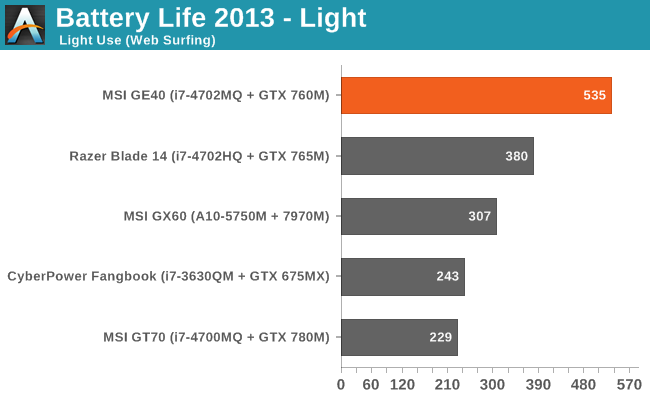
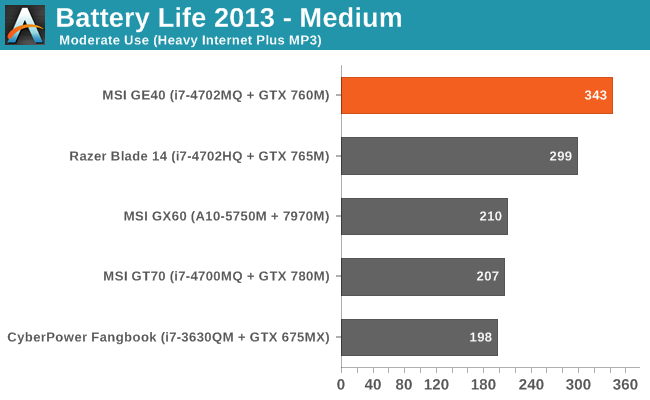
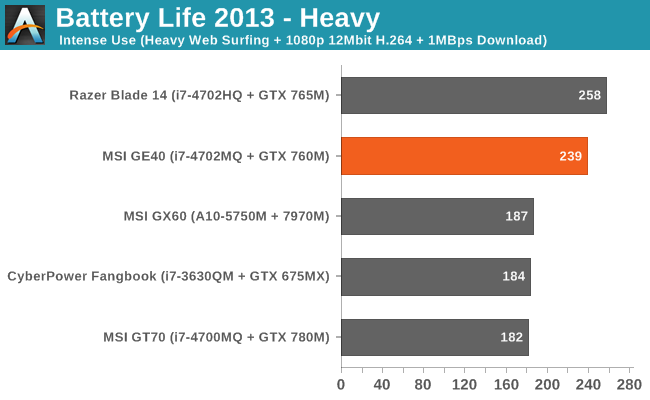

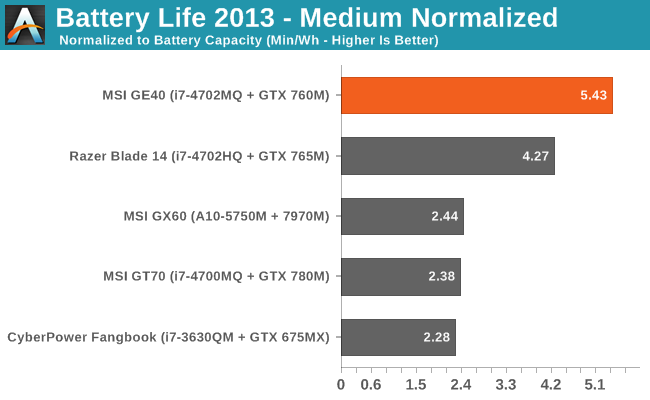
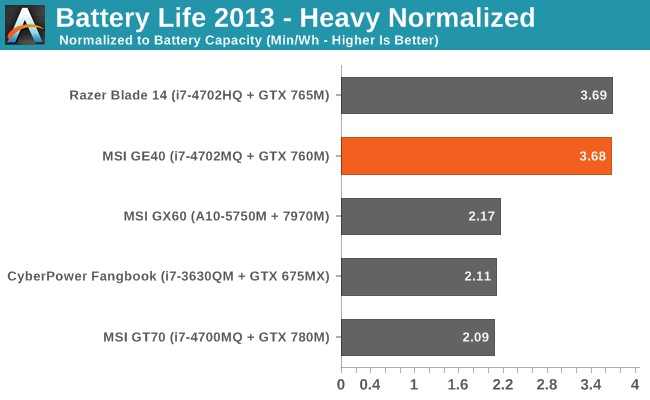
Haswell is a mobile-focused architecture, and it shows. It may not be much faster than Ivy Bridge in many cases, but seeing a viable gaming notebook pull off nearly nine hours of useful battery life is quite impressive. That drops quickly as you put a heavier load on the GE40, with around 5.75 hours of moderately heavy use and four hours of heavy use possible. If you just want to watch 1080p H.264 video, you can expect closer to five hours of battery life. Normalized battery life ends up equaling the Razer Blade in our heavy test while soundly trouncing all contenders in the light and medium tests.
But what about gaming on battery power? I ran a test as requested in the comments, and the results aren't particularly promising. First, battery life while gaming (running Skyrim) ended up at 104 minutes, still well short of the two hour mark. What's potentially worse is that even with all the settings tweaked for higher performance, NVIDIA's drivers (or MSI's BIOS/firmware) throttle GPU performance while on battery power. Plugged in Skyrim was running at a steady 60-70FPS, but once the power cord was unplugged it dropped down to 30-32FPS (with some dips into the low 20s on occasion). It looks like the notebook is shooting for 30FPS and no more when on battery power; I'll see if I can coax any better performance out of it in the morning, but even in the reduced performance mode you're still not going to be gaming for long while unplugged.
“What good were eyes to me? Nothing I could see could bring me joy.”
Perhaps that’s a bit too strong, but if you take the poor LCD from the Razer Blade 14 review and then limit the maximum brightness to 250 nits instead of 450 nits, you have the GE40’s LCD. Viewing angles are as bad as you’ll ever get with TN panels, and while it’s still possible to play games and not feel too bad, any photo editing is best done elsewhere. Here are the numbers:
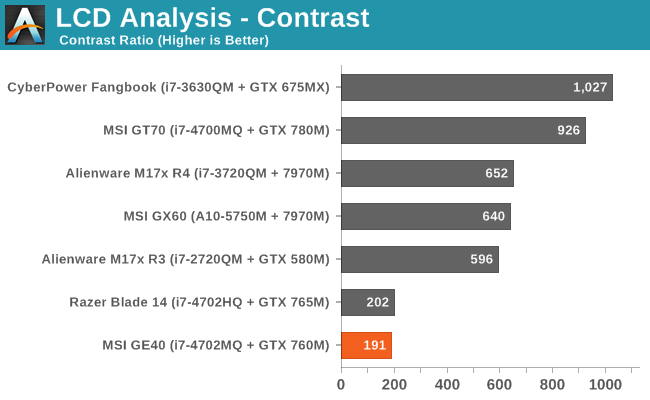
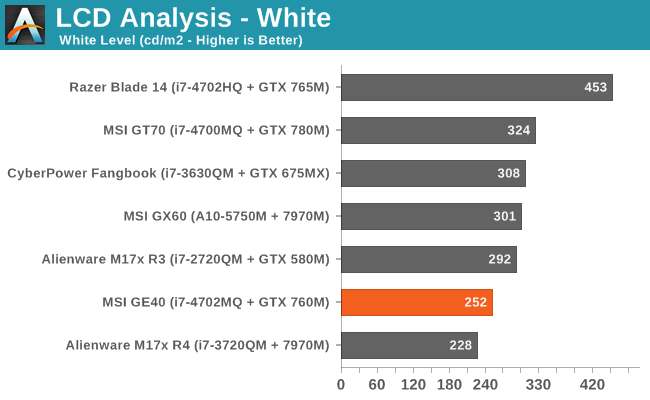
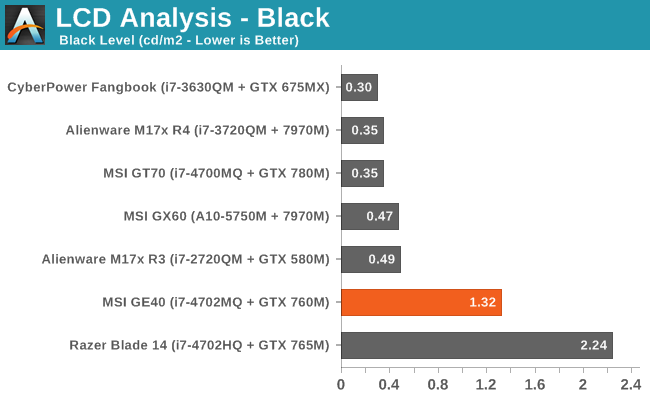
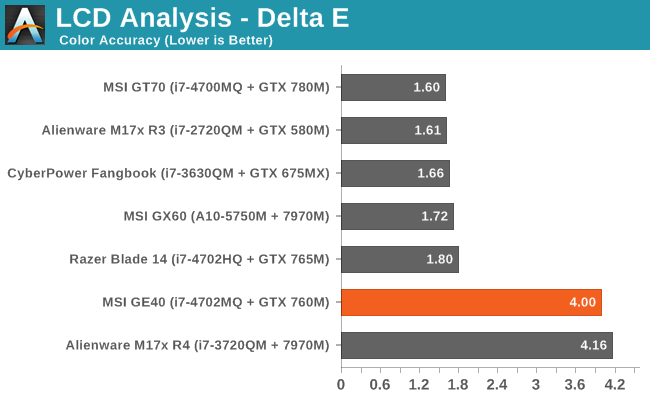

A contrast ratio below 200:1 is simply unacceptable in today’s market. This is the sort of display that will continue to drive users over to tablets. I do worry that something has gone wrong with my i1 Display2 colorimeter, as the DeltaE on the GE40 and M17x R4 are both much higher than I’d expect, so take those figures with a grain of salt until I can confirm my colorimeter is still working, but even if it’s off by a factor of two there’s nothing good to say. Average color accuracy without calibration is far worse, of course: I measured 17.4 average dE with the best result being 8.4 and the worst being 25.5—basically the same as what you see with many Android tablets I guess. Color gamut is also low, but really the contrast needs to be improved before we even worry about color gamut or accuracy.
Too Hot to Handle?
I ran some extended stress testing of the GE40, just to see what might happen. Under a full load, it took about ten minutes before the CPU and GPU had reached more or less equilibrium. It’s a bit warm here in WA right now, and I don’t have AC, so ambient temperatures were around 80-85F (27-29C), but even so the maximum CPU temperature of 98C is a concern. The GTX 760M didn’t have as much trouble, maxing out at a still-toasty-but-not-horrible 80C.
In practice, these figures aren’t even unusual; an extended session of Metro: Last Light looping our Value settings at 1600x900 hit 98C/84C on the CPU/GPU (average temps of 95.5C/81.4C), so the GPU actually got a bit hotter when the CPU wasn’t fully loaded. Idle temperatures at least are good, sitting around 46C/34C, and the surfaces of the GE40 for the most part are not too hot—one of the benefits of using plastic on the bottom of the chassis. The only real hot spot is on the left hand side near the exhaust, as you would expect. Still, the cooling is definitely pushing the limits of what we would deem “acceptable”—a year or two down the road when the cooling fins have a fine layer of dust and grime on them and we could easily be talking about an overheating notebook.
It’s Also Relatively Noisy
We haven’t had a lot of time with Haswell so far, so it’s difficult to say whether the temperatures in the upper 90s that we’re seeing under sustained load are normal or problematic. It’s very hard to get good thermals, high performance, and low noise levels in the same package, particularly if that package is less than an inch thick like the GE40. We’ve seen that thermals are definitely pushing the limit of what we’re comfortable with, but noise isn’t all that great either. At idle, we measured noise levels of 34.7dB while pretty much any reasonable gaming workload increased that to a maximum of 44.4dB; even under light loads (e.g. surfing the web), the fan will often spin up a bit to the 37dB range. Our full-load stress testing didn’t increase the noise, and even covering the exhaust with my hand didn’t create any additional noise (though that was mighty hot!), so the fan is basically topped out when gaming.










93 Comments
View All Comments
hfm - Wednesday, July 17, 2013 - link
Also, the Razer 14 DOES NOT throttle on battery. You can get around 1.5-2 hours of gaming on the Razer 14 from what i've heard.JarredWalton - Thursday, July 18, 2013 - link
I would be very surprised if the Razer doesn't do something similar to the GE40 on battery power. It's basically the GPU not running at full speed because it doesn't need to in order to hit 30FPS -- so in games like Metro, it will actually run at full speed but in others it won't. Anyway, I did't test the Razer so I can't say for certain, but I've yet to see a GTX notebook that doesn't adjust the GPU clocks/performance down on battery power.Jon Tseng - Tuesday, July 16, 2013 - link
Cheers for the response - much appreciated. Sorry for sounding a bit grumpy earlier!The reason I ask is I've been getting wildly different estimates of gaming battery life for the Razor 14 all over the web - some websites say 1 hour, some websites say 2-3. It would be good to have some definitely numbers.
I don't think gaming battery life is /always/ that bad. I can get 2-ish hours gaming on my m11x on battery power. Definitely for classic "gaming laptop luggages" where the battery is effectively a 2 kilo UPS system you're lucky to get beyond 45 mins, but for smaller form factor gaming laptops I think you can do better than that.
1 hour isn't really sufficient because as soon as you boot up you have a lurking paranoia about the batt meter going down. 1.5+ is where you can have a proper "session" between destinations...
noeldillabough - Tuesday, July 16, 2013 - link
I can play casual games (think world of warcraft, portal etc) on my X230 for about 2.5h. I'm expecting the haswell version to do slightly better. Note its on a low res screen, hopefully these are a dying breed but every laptop seems to continue to come out with them. Higher res screen is going to use more GPU and battery so it might be a wash.JarredWalton - Tuesday, July 16, 2013 - link
That was sort of the point I was trying to make: if you have more than just a CPU with iGPU (or an APU in the AMD world), you can't get reasonable gaming performance and great battery life. Games will max out the TDP of both the CPU and GPU, generally speaking -- though it's possible to throttle the GPUs to help reduce the load, which both AMD and NVIDIA do by default. If you have a 70Wh battery and a CPU/APU that has a 17W-35W TDP, though, you can get 2+ hours. You just won't be running at high detail and 1600x900.adityarjun - Tuesday, July 16, 2013 - link
Jarred, please do a review of the Alienware 14 and 17. I think they have started to offer some decent IPS screens with matte options and I would love to read Anandtech’s take on these laptops before making a purchase.realjetavenger - Tuesday, July 16, 2013 - link
+1. Would love to see how the Alienware 14 stacks up against the Razer 14 and this ge40.hfm - Wednesday, July 17, 2013 - link
Here's how it stacks up to the Razer 14.1. 768p panel is too far the other direction and it's not high quality, but performance at that res is great.
2. 1080p panel will be slower than the Razer 14. If you ask me 1080p for gaming on a 765M is not going to give much longevity. The panel itself is above average so if you are planning on doing work on it and gaming is secondary it's probably a better overall option.
3. I've read the Alienware 14 is hot and loud. Razer 14 is hot, but not that loud.
4. Alienware 14 is much bigger and 2 lbs heavier.
5. Alienware 14 can be cheaper or about the same price as the razer depending on config. The razer is only configurable storage size.
I don't think it's fair to include the ge40 in that discussion as it's outclassed by both of them from a gaming standpoint.
wrkingclass_hero - Tuesday, July 16, 2013 - link
Typo on closing thoughts page:MSI tries to pick up the fumble with their GE40, but unfortunately there display happens to be even worse than the Razer Blade 14 panel!
"there" should be their
Darkstone - Tuesday, July 16, 2013 - link
I think anandtech needs to give more information about the cooling in notebooks reviews.For starters, only the temperatures are reported. But i think the temperatures are actually largely irrelevant. It doesn't matter to me if the CPU is hitting 70° or 95° as long it does not throttle down.
I usually load up prime95 and take a close look at the 'package power' meter in HWinfo. If it ever drops below the TDP, the cooling will get in trouble when running basic CPU-only simulations.
Stressing the GPU in a controlled enthronement is a bit harder to do. I like RTHDBIBL, but the scene complexity is a bit low for modern GPU's. Maybe try one of unigine's older tests. Im not sure if they support benchmark looping.
If it can't run prime95 and a GPU stress test at the same time without throtteling on the CPU part, it's probably not up to the task of playing games all day long. That's valuable information, much more valuable than the temperature of the CPU. The GE40 reaches 98° unload load. But at what clock speed is it running? 800 Mhz? 2.x Mhz?